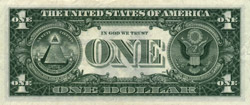
More changes were soon coming. In 1955, Congress ordered the motto "In God We Trust", which had long appeared on U.S. coins, to be added to all of the paper currency designs as well. At the time, the BEP was planning yet another upgrade of its presses, this time to models that could handle even larger sheets of 32 notes each. It was decided, therefore, that the new motto would be added to the back design of each denomination as the new 32-subject printing plates were adopted.

Once again, it was the $1 SC that was first to get the makeover. The new notes, dated Series 1957, had face designs basically unchanged from those of the 1935 series, but had "In God We Trust" added to the back just above the large "ONE". Since the $1 denomination made up the bulk of the BEP's production, and since the new 32-subject presses replaced the old 18-subject ones gradually over a period of years, there was an extended interval during which the 1935 and 1957 series $1 SCs were both in production. In particular, Series 1935F through 1935H all actually began printing after the Series 1957 notes were already in circulation. Therefore, the BEP finally added the "In God We Trust" to some of the 18-subject back plates as well, so that part of Series 1935G and all of Series 1935H were printed with the motto.
(Actually, there were also many very minor differences between the 1935 and 1957 $1 designs. The new 32-subject presses differed from the older 18-subject presses in one important respect: They were designed to print on dry paper, rather than the dampened sheets required by the BEP's older equipment. The wet-printed notes had always shrunk slightly as they dried after printing, so in order to create notes of the same size using the dry-printing process, the master design engraving had to be made slightly smaller. Evidence of this can be seen at several places in the 1957-series designs, perhaps most prominently in Washington's portrait, where considerably less of his ruffled collar is visible within the oval frame.)
By 1963, the BEP finally had enough new presses in operation to produce all $1 notes, and so other denominations also began to be printed from larger plates with "In God We Trust" added. The FRNs and USNs thus became Series 1963. But on these types of notes, the switch to the new plates was also accompanied by substantial changes to the wording on the faces of the notes. On both types, the legend was shortened to read simply, "This note is legal tender for all debts, public and private". Also, the words "will pay to the bearer on demand" were eliminated from the obligation on both types. This effectively removed the obligation altogether, since there remained only the phrase "The United States of America" and the dollar value.
The USNs, by this time printed only in small quantities, made the transition from the 1953 series to the 1963 series fairly quickly. But the FRNs, like the $1 SC, were printed in both the older and newer styles for a time. Series 1950E went into production after both Series 1963 and 1963A, as there were a few old 18-subject presses still in use as late as 1968; but this time no attempt was made to add "In God We Trust" to the old plates. By 1966, all denominations had been printed with the new designs, the $50 being last.
The $5 and $10 SCs never received the new motto at all; they had gone out of production before they had the chance.
Next: The FRNs stand alone